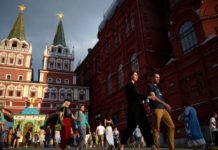Miguel Diaz-Canel was officially declared as Cuba’s new president Thursday, a day after a vote in the National Assembly cleared the way for a leader not named Castro for the first time in nearly six decades.
As the current first vice president, Díaz-Canel, 59, was the sole candidate to succeed an aging Raúl Castro as president, part of an effort to ensure that the country’s single-party system outlasts the aging revolutionaries who created it. Diaz-Canel was not yet born when Raúl’s older brother, the late Fidel Castro, led his revolution in 1959.
Castro, 86, will remain head of the Communist Party, designated by the constitution as “the superior guiding force of society and the state.” As a result, Castro is almost certain to remain the most powerful person in Cuba, an island of 11 million, for the time being, analysts said.
Nominated as new first vice president was Salvador Valdes Mesa, a 72-year-old Afro-Cuban former union official who has held a long series of high posts in the Cuban government, the Associated Press reported. The government’s official Candidacy Commission also nominated another five vice presidents of the Council of State, Cuba’s highest government body. Only one of the five, 85-year-old Ramiro Valdez, was among the revolutionaries who fought with the Castros in the eastern Sierra Maestra mountains, the AP said.
In remarks following the National Assembly’s announcement, Diaz-Canel, an electrical engineer by training, acknowledged that Raúl Castro would remain as the head of the armed forces, which runs much of the Cuban economy and tourism industry, CNN reported.
Under President Obama, the U.S. restored diplomatic relations with Cuba after five decades. But the goods trade embargo, which can be rescinded only by Congress, remained in force.
President Trump last summer announced that he was reversing part of what he called a “terrible and misguided deal” with Cuba under Obama and reinstated travel and commercial restrictions in an attempt to obtain additional concessions from the Cuban government.
Read: Is it safe to travel to Cuba after mysterious ‘sonic weapon’ attacks?
Cuba saw a 34% increase in visits from Cuban Americans and other U.S. travelers in 2016 and was projected to have drawn an additional 4.1 million visitors in 2017 before slowing in 2018 due to the reversal of the travel policies expanded under Obama.
Source : MTV













